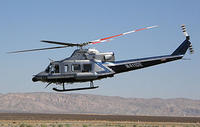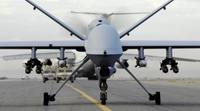-
Drones used by police, firefighters raise privacy concerns
DHS is accelerating the use of unmanned drones by police and firefighters around the country with the intent of detecting fires, radiation leaks, and other potential threats, but Congress and privacy advocacy organizations think the se of drones raises several privacy issues
-
-
UAVs with dexterous arms to help in infrastructure repair and disaster recovery
With current technology, most UAVs perform passive tasks such as surveillance and reconnaissance missions, tasks which are performed well above ground; researchers are interested in how UAVs might interact with objects at or near ground level; a UAV with dexterous arms could perform a wide range of active near-ground missions, from infrastructure repair and disaster recovery to border inspection and agricultural handling
-
-
Raytheon's Space Fence technology tracks space debris

Space debris threatens systems the U.S. military and economy depend on every day, including satellites that power navigation, weather and critical infrastructures; the Space Fence program is capable of detecting more and much smaller objects in low earth orbit
-
-
Researchers say spoofed GPS signals can be countered
From cars to commercial airplanes to military drones, global positioning system (GPS) technology is everywhere — and researchers have known for years that it can be hacked, or as they call it, “spoofed”; the best defense, they say, is to create countermeasures that unscrupulous GPS spoofers can not deceive
-
-
New biometrics discipline -- foot biometrics – for security, disease detection
Identity science takes a giant, well, step forward with a new discipline in biometrics: foot biometrics; researchers at the new $1.5 million per year Pedo-Biometrics Research and Identity Automation Lab will test insole sensory system prototypes for a variety of identification uses, from security to detecting the onset of such diseases as diabetes and Parkinson’s
-
-
Unmanned systems emulate animals’ conditioned fear-response mechanism for self-preservation
When animals in the wild engage in eating or grazing, their eyes, ears, and sense of smell continuously monitor the environment for any sense of danger; researchers developed a similar conditioned fear-response mechanism for unmanned systems
-
-
Two companies offer tower-based border security systems
General Dynamics C4 Systems and EADS North America have joined forces to develop border protection and security systems which exploit the both companies’ strength; the team offers tower-based, integrated radar and sensor systems for an “always-on, ever-aware” picture of human activity in and around national borders
-
-
ONR sensor and software suite tracks, hunts down more than 600 suspect boats
A new sensor and software suite sponsored by the Office of Naval Research recently returned from West Africa after helping partner nations track and identify target vessels of interest as part of an international maritime security operation
-
-
UAV Code of Conduct for unmanned aircraft systems operations released
The Association for Unmanned Vehicle Systems International (AUVSI) has published the Unmanned Aircraft System Operations Industry Code of Conduct, a set of guidelines to provide AUVSI members — and those who design, test, and operate unmanned aerial systems (UAS) for public and civil use — with recommendations for their safe, non-intrusive operation
-
-
A third Bell 412 helicopter delivered to NYPD for counterterrorism missions

The NYPD dedicated many hours to designing the specifications of the department’s third Bell 412 to meet the diverse needs of the police department; one of the counterterrorism additions to the Bell 412 is a radiation detection system that can identify radiation signatures from an altitude of 200 feet in an effort to protect the city from nuclear bomb threats
-
-
UAV Code of Conduct for unmanned aircraft systems operations released
The Association for Unmanned Vehicle Systems International (AUVSI) has published the Unmanned Aircraft System Operations Industry Code of Conduct, a set of guidelines to provide AUVSI members — and those who design, test, and operate unmanned aerial systems (UAS) for public and civil use — with recommendations for their safe, non-intrusive operation
-
-
Computer-based methodology for cultural intelligence and security
Cultural differences are a major challenge facing intelligence agencies, researchers from Israel and the United States have developed computer-based methodology to improve knowledge, apply data, and better decipher these nuances and biases
-
-
First successful "spoofing" of UAVs demonstrated

A research team successfully demonstrated for the first time that the GPS signals of an unmanned aerial vehicle (UAV), or drone, can be commandeered by an outside source — a discovery that could factor heavily into the implementation of a new federal mandate to allow thousands of civilian drones into the U.S. airspace by 2015
-
-
DARPA’s UAVForge shows challenge of developing perch and stare UAV
DARPA’s UAVForge is a crowdsourcing competition to design, build, and manufacture an advanced small UAV; the competition aims to determine whether a loosely-connected community of UAV enthusiasts could develop a militarily relevant back-pack portable UAV with specific capabilities
-
-
New eight-sensor carousel sensor for perimeter, internal environments
FutureSentry shows its Carousel, a monitoring device offering 360 degrees of coverage through eight, adjustable, articulating sensor heads; its close-range detection capabilities allow for it to be deployed in internal environments
-
- All
- Regional
- Water
- Biometrics
- Borders/Immig
- Business
- Cybersecurity
- Detection
- Disasters
- Government
- Infrastructure
- International
- Public health
- Public Safety
- Communication interoperabillity
- Emergency services
- Emergency medical services
- Fire
- First response
- IEDs
- Law Enforcement
- Law Enforcement Technology
- Military technology
- Nonlethal weapons
- Nuclear weapons
- Personal protection equipment
- Police
- Notification /alert systems
- Situational awareness
- Weapons systems
- Sci-Tech
- Sector Reports
- Surveillance
- Transportation
Advertising & Marketing: advertise@newswirepubs.com
Editorial: editor@newswirepubs.com
General: info@newswirepubs.com
2010-2011 © News Wire Publications, LLC News Wire Publications, LLC
220 Old Country Road | Suite 200 | Mineola | New York | 11501
Permissions and Policies
Editorial: editor@newswirepubs.com
General: info@newswirepubs.com
2010-2011 © News Wire Publications, LLC News Wire Publications, LLC
220 Old Country Road | Suite 200 | Mineola | New York | 11501
Permissions and Policies
